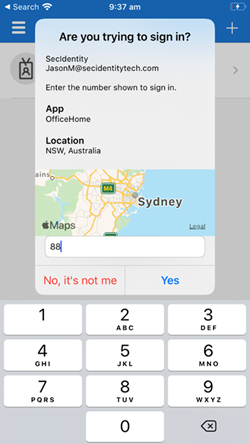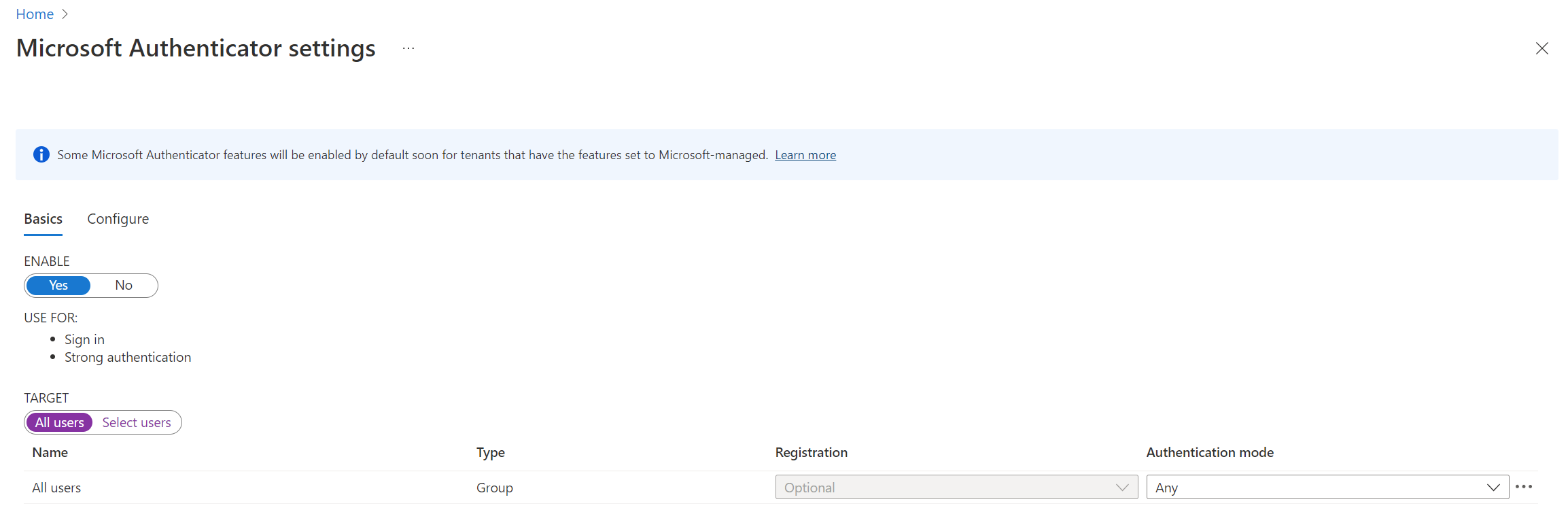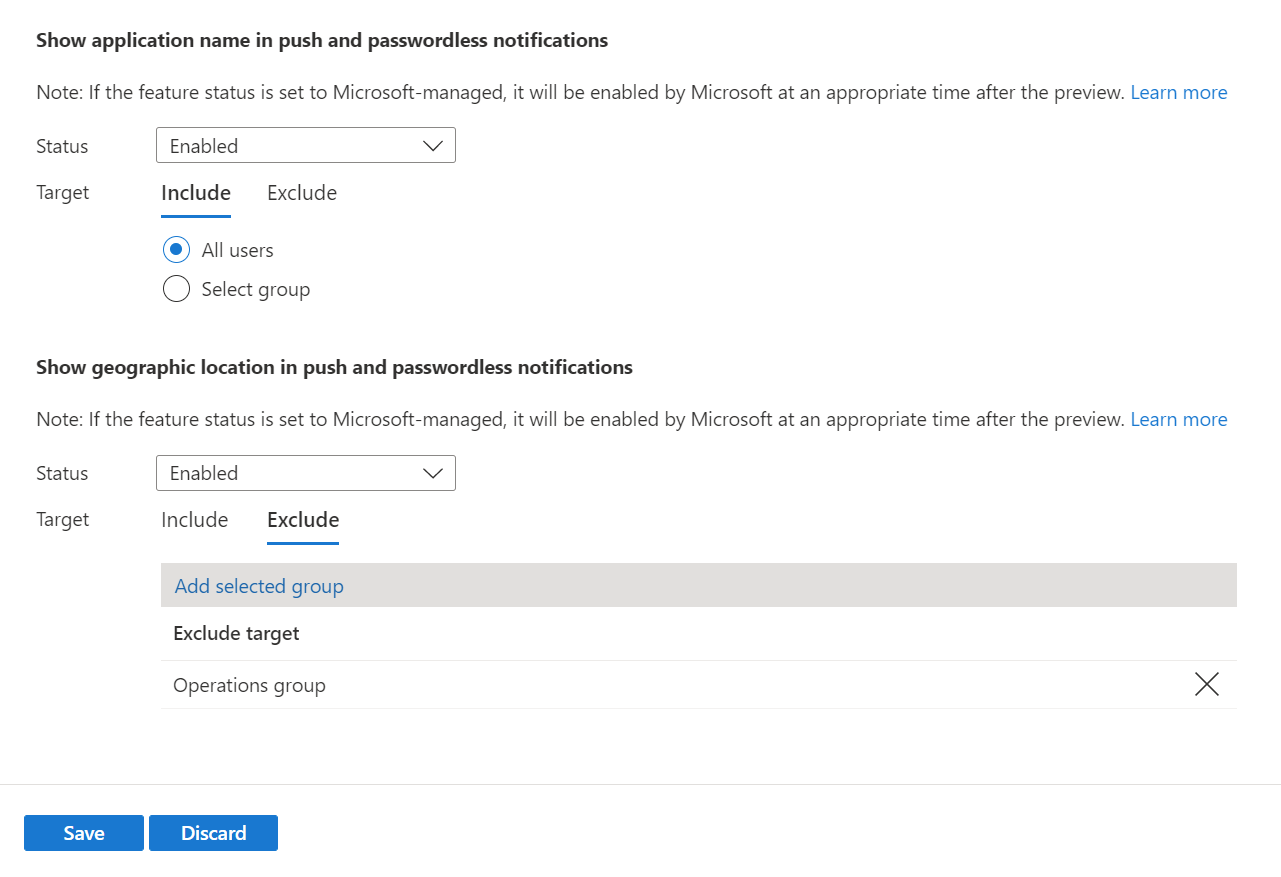Use additional context in Authenticator notifications - Authentication methods policy
This article discusses how to improve the security of user sign-in by adding the application name and geographic location of the sign-in to Authenticator passwordless and push notifications.
Prerequisites
- Your organization needs to enable Authenticator passwordless and push notifications for some users or groups by using the new Authentication methods policy. You can edit the Authentication methods policy by using the Microsoft Entra admin center or Microsoft Graph API.
- Additional context can be targeted to only a single group, which can be dynamic or nested. The group can be synchronized from on-premises or cloud-only.
Passwordless phone sign-in and multifactor authentication
When a user receives a passwordless phone sign-in or multifactor authentication (MFA) push notification in Authenticator, they see the name of the application that requests the approval and the location based on the IP address from where the sign-in originated.

Admins can combine additional context with number matching to further improve sign-in security.

Policy schema changes
You can enable and disable the application name and geographic location separately. Under featureSettings, you can use the following name mapping for each feature:
- Application name:
displayAppInformationRequiredState - Geographic location:
displayLocationInformationRequiredState
Note
Make sure that you use the new policy schema for Microsoft Graph APIs. In Graph Explorer, you need to consent to the Policy.Read.All and Policy.ReadWrite.AuthenticationMethod permissions.
Identify your single target group for each of the features. Then use the following API endpoint to change displayAppInformationRequiredState or displayLocationInformationRequiredState properties under featureSettings to enabled and include or exclude the groups you want:
GET https://graph.microsoft.com/v1.0/authenticationMethodsPolicy/authenticationMethodConfigurations/MicrosoftAuthenticator
For more information, see microsoftAuthenticatorAuthenticationMethodConfiguration resource type.
Example of how to enable additional context for all users
In featureSettings, change displayAppInformationRequiredState and displayLocationInformationRequiredState from default to enabled.
The value of Authentication mode is either any or push, depending on whether or not you also want to enable passwordless phone sign-in. In these examples, we use any, but if you don't want to allow passwordless, use push.
You might need to PATCH the entire schema to prevent overwriting any previous configuration. In that case, do a GET first. Then update only the relevant fields and then PATCH. The following example shows how to update displayAppInformationRequiredState and displayLocationInformationRequiredState under featureSettings.
Only users who are enabled for Authenticator under includeTargets see the application name or geographic location. Users who aren't enabled for Authenticator don't see these features.
//Retrieve your existing policy via a GET.
//Leverage the Response body to create the Request body section. Then update the Request body similar to the Request body as shown below.
//Change the Query to PATCH and Run query
{
"@odata.context": "https://graph.microsoft.com/v1.0/$metadata#authenticationMethodConfigurations/$entity",
"@odata.type": "#microsoft.graph.microsoftAuthenticatorAuthenticationMethodConfiguration",
"id": "MicrosoftAuthenticator",
"state": "enabled",
"featureSettings": {
"displayAppInformationRequiredState": {
"state": "enabled",
"includeTarget": {
"targetType": "group",
"id": "all_users"
},
"excludeTarget": {
"targetType": "group",
"id": "00000000-0000-0000-0000-000000000000"
}
},
"displayLocationInformationRequiredState": {
"state": "enabled",
"includeTarget": {
"targetType": "group",
"id": "all_users"
},
"excludeTarget": {
"targetType": "group",
"id": "00000000-0000-0000-0000-000000000000"
}
}
},
"includeTargets@odata.context": "https://graph.microsoft.com/v1.0/$metadata#authenticationMethodsPolicy/authenticationMethodConfigurations('MicrosoftAuthenticator')/microsoft.graph.microsoftAuthenticatorAuthenticationMethodConfiguration/includeTargets",
"includeTargets": [
{
"targetType": "group",
"id": "all_users",
"isRegistrationRequired": false,
"authenticationMode": "any",
}
]
}
Example of how to enable application name and geographic location for separate groups
In featureSettings, change displayAppInformationRequiredState and displayLocationInformationRequiredState from default to enabled.
Inside includeTarget for each featureSetting, change the ID from all_users to the object ID of the group from the Microsoft Entra admin center.
You need to PATCH the entire schema to prevent overwriting any previous configuration. We recommend that you do a GET first. Then update only the relevant fields and then PATCH. The following example shows an update to displayAppInformationRequiredState and displayLocationInformationRequiredState under featureSettings.
Only users who are enabled for Authenticator under includeTargets see the application name or geographic location. Users who aren't enabled for Authenticator don't see these features.
{
"@odata.context": "https://graph.microsoft.com/v1.0/$metadata#authenticationMethodConfigurations/$entity",
"@odata.type": "#microsoft.graph.microsoftAuthenticatorAuthenticationMethodConfiguration",
"id": "MicrosoftAuthenticator",
"state": "enabled",
"featureSettings": {
"displayAppInformationRequiredState": {
"state": "enabled",
"includeTarget": {
"targetType": "group",
"id": "44561710-f0cb-4ac9-ab9c-e6c394370823"
},
"excludeTarget": {
"targetType": "group",
"id": "00000000-0000-0000-0000-000000000000"
}
},
"displayLocationInformationRequiredState": {
"state": "enabled",
"includeTarget": {
"targetType": "group",
"id": "a229e768-961a-4401-aadb-11d836885c11"
},
"excludeTarget": {
"targetType": "group",
"id": "00000000-0000-0000-0000-000000000000"
}
}
},
"includeTargets@odata.context": "https://graph.microsoft.com/v1.0/$metadata#authenticationMethodsPolicy/authenticationMethodConfigurations('MicrosoftAuthenticator')/microsoft.graph.microsoftAuthenticatorAuthenticationMethodConfiguration/includeTargets",
"includeTargets": [
{
"targetType": "group",
"id": "all_users",
"isRegistrationRequired": false,
"authenticationMode": "any",
}
]
}
To verify, run GET again and verify the object ID:
GET https://graph.microsoft.com/v1.0/authenticationMethodsPolicy/authenticationMethodConfigurations/MicrosoftAuthenticator
Example of how to disable the application name and only enable the geographic location
In featureSettings, change the state of displayAppInformationRequiredState to default or disabled and displayLocationInformationRequiredState to enabled.
Inside includeTarget for each featureSetting value, change the ID from all_users to the object ID of the group from the Microsoft Entra admin center.
You need to PATCH the entire schema to prevent overwriting any previous configuration. We recommend that you do a GET first. Then update only the relevant fields and then PATCH. The following example shows an update to displayAppInformationRequiredState and displayLocationInformationRequiredState under featureSettings.
Only users who are enabled for Authenticator under includeTargets see the application name or geographic location. Users who aren't enabled for Authenticator don't see these features.
{
"@odata.context": "https://graph.microsoft.com/v1.0/$metadata#authenticationMethodConfigurations/$entity",
"@odata.type": "#microsoft.graph.microsoftAuthenticatorAuthenticationMethodConfiguration",
"id": "MicrosoftAuthenticator",
"state": "enabled",
"featureSettings": {
"displayAppInformationRequiredState": {
"state": "disabled",
"includeTarget": {
"targetType": "group",
"id": "44561710-f0cb-4ac9-ab9c-e6c394370823"
},
"excludeTarget": {
"targetType": "group",
"id": "00000000-0000-0000-0000-000000000000"
}
},
"displayLocationInformationRequiredState": {
"state": "enabled",
"includeTarget": {
"targetType": "group",
"id": "a229e768-961a-4401-aadb-11d836885c11"
},
"excludeTarget": {
"targetType": "group",
"id": "00000000-0000-0000-0000-000000000000"
}
}
},
"includeTargets@odata.context": "https://graph.microsoft.com/v1.0/$metadata#authenticationMethodsPolicy/authenticationMethodConfigurations('MicrosoftAuthenticator')/microsoft.graph.microsoftAuthenticatorAuthenticationMethodConfiguration/includeTargets",
"includeTargets": [
{
"targetType": "group",
"id": "all_users",
"isRegistrationRequired": false,
"authenticationMode": "any",
}
]
}
Example of how to exclude a group from the application name and geographic location
In addition, for each of the features, you change the ID of excludeTarget to the object ID of the group from the Microsoft Entra admin center. This change excludes that group from seeing the application name or geographic location.
You need to PATCH the entire schema to prevent overwriting any previous configuration. We recommend that you do a GET first. Then update only the relevant fields and then PATCH. The following example shows an update to displayAppInformationRequiredState and displayLocationInformationRequiredState under featureSettings.
Only users who are enabled for Authenticator under includeTargets see the application name or geographic location. Users who aren't enabled for Authenticator don't see these features.
{
"@odata.context": "https://graph.microsoft.com/v1.0/$metadata#authenticationMethodConfigurations/$entity",
"@odata.type": "#microsoft.graph.microsoftAuthenticatorAuthenticationMethodConfiguration",
"id": "MicrosoftAuthenticator",
"state": "enabled",
"featureSettings": {
"displayAppInformationRequiredState": {
"state": "enabled",
"includeTarget": {
"targetType": "group",
"id": "44561710-f0cb-4ac9-ab9c-e6c394370823"
},
"excludeTarget": {
"targetType": "group",
"id": "5af8a0da-5420-4d69-bf3c-8b129f3449ce"
}
},
"displayLocationInformationRequiredState": {
"state": "enabled",
"includeTarget": {
"targetType": "group",
"id": "a229e768-961a-4401-aadb-11d836885c11"
},
"excludeTarget": {
"targetType": "group",
"id": "b6bab067-5f28-4dac-ab30-7169311d69e8"
}
}
},
"includeTargets@odata.context": "https://graph.microsoft.com/v1.0/$metadata#authenticationMethodsPolicy/authenticationMethodConfigurations('MicrosoftAuthenticator')/microsoft.graph.microsoftAuthenticatorAuthenticationMethodConfiguration/includeTargets",
"includeTargets": [
{
"targetType": "group",
"id": "all_users",
"isRegistrationRequired": false,
"authenticationMode": "any",
}
]
}
Example of removing the excluded group
In featureSettings, change the states of displayAppInformationRequiredState from default to enabled. Change the ID of excludeTarget to 00000000-0000-0000-0000-000000000000.
You need to PATCH the entire schema to prevent overwriting any previous configuration. We recommend that you do a GET first. Then update only the relevant fields and then PATCH. The following example shows an update to displayAppInformationRequiredState and displayLocationInformationRequiredState under featureSettings.
Only users who are enabled for Authenticator under includeTargets see the application name or geographic location. Users who aren't enabled for Authenticator don't see these features.
{
"@odata.context": "https://graph.microsoft.com/v1.0/$metadata#authenticationMethodConfigurations/$entity",
"@odata.type": "#microsoft.graph.microsoftAuthenticatorAuthenticationMethodConfiguration",
"id": "MicrosoftAuthenticator",
"state": "enabled",
"featureSettings": {
" displayAppInformationRequiredState ": {
"state": "enabled",
"includeTarget": {
"targetType": "group",
"id": "1ca44590-e896-4dbe-98ed-b140b1e7a53a"
},
"excludeTarget": {
"targetType": "group",
"id": " 00000000-0000-0000-0000-000000000000"
}
}
},
"includeTargets@odata.context": "https://graph.microsoft.com/v1.0/$metadata#authenticationMethodsPolicy/authenticationMethodConfigurations('MicrosoftAuthenticator')/microsoft.graph.microsoftAuthenticatorAuthenticationMethodConfiguration/includeTargets",
"includeTargets": [
{
"targetType": "group",
"id": "all_users",
"isRegistrationRequired": false,
"authenticationMode": "any"
}
]
}
Turn off additional context
To turn off additional context, you need to PATCH displayAppInformationRequiredState and displayLocationInformationRequiredState from enabled to disabled/default. You can also turn off only one of the features.
{
"@odata.context": "https://graph.microsoft.com/v1.0/$metadata#authenticationMethodConfigurations/$entity",
"@odata.type": "#microsoft.graph.microsoftAuthenticatorAuthenticationMethodConfiguration",
"id": "MicrosoftAuthenticator",
"state": "enabled",
"featureSettings": {
"displayAppInformationRequiredState": {
"state": "disabled",
"includeTarget": {
"targetType": "group",
"id": "44561710-f0cb-4ac9-ab9c-e6c394370823"
},
"excludeTarget": {
"targetType": "group",
"id": "00000000-0000-0000-0000-000000000000"
}
},
"displayLocationInformationRequiredState": {
"state": "disabled",
"includeTarget": {
"targetType": "group",
"id": "a229e768-961a-4401-aadb-11d836885c11"
},
"excludeTarget": {
"targetType": "group",
"id": "00000000-0000-0000-0000-000000000000"
}
}
},
"includeTargets@odata.context": "https://graph.microsoft.com/v1.0/$metadata#authenticationMethodsPolicy/authenticationMethodConfigurations('MicrosoftAuthenticator')/microsoft.graph.microsoftAuthenticatorAuthenticationMethodConfiguration/includeTargets",
"includeTargets": [
{
"targetType": "group",
"id": "all_users",
"isRegistrationRequired": false,
"authenticationMode": "any",
}
]
}
Enable additional context in the Microsoft Entra admin center
To enable the application name or geographic location in the Microsoft Entra admin center, follow these steps:
Sign in to the Microsoft Entra admin center as at least an Authentication Policy Administrator.
Browse to Protection > Authentication methods > Microsoft Authenticator.
On the Basics tab, select Yes and All users to enable the policy for everyone. Change Authentication mode to Any.
Only users who are enabled for Authenticator here are included in the policy to show the application name or geographic location of the sign-in, or excluded from it. Users who aren't enabled for Authenticator can't see the application name or geographic location.

On the Configure tab, for Show application name in push and passwordless notifications, change Status to Enabled. Choose who to include or exclude from the policy, and then select Save.

Then do the same for Show geographic location in push and passwordless notifications.

You can configure the application name and geographic location separately. For example, the following policy enables the application name and geographic location for all users but excludes the Operations group from seeing the geographic location.

Known issues
Additional context isn't supported for Network Policy Server (NPS) or Active Directory Federation Services.
Users can modify the location reported by iOS and Android devices. As a result, Authenticator is updating its security baseline for Location-Based Access Control (LBAC) Conditional Access policies. Authenticator denies authentications where the user might be using a different location than the actual GPS location of the mobile device where Authenticator is installed.
In the November 2023 release of Authenticator, users who modify the location of their device see a denial message in Authenticator when they do an LBAC authentication. Beginning in January 2024, any users who run older Authenticator versions are blocked from LBAC authentication with a modified location:
- Authenticator version 6.2309.6329 or earlier on Android
- Authenticator version 6.7.16 or earlier on iOS
To find which users run older versions of Authenticator, use Microsoft Graph APIs.